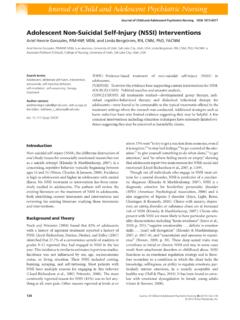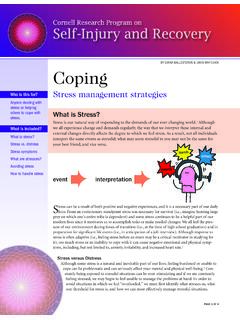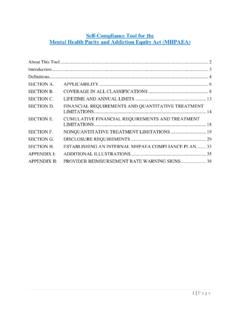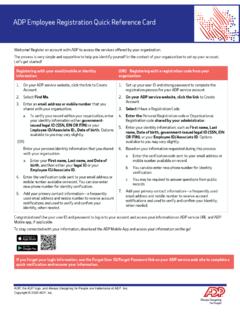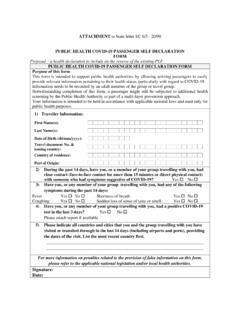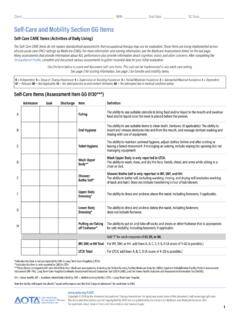Transcription of The Non-Suicidal Self-Injury Assessment Tool (NSSI-AT)
1 1 2007. Cornell Research Program on self -Injurious Behaviors in Adolescents and Young Adults The Non-Suicidal Self-Injury Assessment Tool (NSSI-AT) Developed by: Janis Whitlock and Amanda Purington The Cornell Research Program on Self-Injury and Recovery Revised: March 15, 2013 How to Interpret this Document: This document shows main questions as well as sub-questions, as indicated in colored text. The response option that triggers a sub-question will appear in color (most are blue, though other levels of sub-questions also appear in red). The sub-question that relates to that response option appears immediately below and is in the same color as the response option that triggers the sub-question. If more than one sub-question follows from this one response option, the additional sub-questions appear below in the same color. If a sub-question has another sub-question within it, the same pattern follows (the response option that triggers the sub-question is in a color that matches the color of the text of the sub-question below) though it will be in a different color from the first sub-question.
2 Citation: Whitlock, , Exner-Cortens, D. & Purington, A. (under review). Validity and reliability of the Non-Suicidal Self-Injury Assessment test (NSSI-AT). 2 2007. Cornell Research Program on self -Injurious Behaviors in Adolescents and Young Adults A. Primary and secondary NSSI characteristics 1. Have you ever done any of the following with the purpose of intentionally hurting yourself?1 o Severely scratched or pinched with fingernails or other objects to the point that bleeding occurs or marks remain on the skin o Cut wrists, arms, legs, torso or other areas of the body o Dripped acid onto skin o Carved words or symbols into the skin o Ingested a caustic substance(s) or sharp object(s) (Drano, other cleaning substances, pins, etc.) o Bitten yourself to the point that bleeding occurs or marks remain on the skin o Tried to break your own bone(s) o Broke your own bone(s) o Ripped or torn skin o Burned wrists, hands, arms, legs, torso or other areas of the body o Rubbed glass into skin or stuck sharp objects such as needles, pins, and staples into or underneath the skin (not including tattooing, body piercing, or needles used for medication use) o Banged or punched objects to the point of bruising or bleeding o Punched or banged oneself to the point of bruising or bleeding o Intentionally prevented wounds from healing o Engaged in fighting or other aggressive activities with the intention of getting hurt 2.
3 Are there any other ways that you have physically hurt or mutilated your body with the purpose of intentionally hurting yourself? o Yes; please specify o No B. Functions 3. How true are the following statements about why you hurt yourself? Please select the most accurate response. I hurt Strongly Disagree (1) Somewhat Disagree (2) Somewhat Agree (3) Strongly Agree (4) o ..to feel something o ..because my friends hurt themselves o ..as a self -punishment or to atone for sins o ..to get a rush or surge of energy o ..to deal with frustration o ..to cope with uncomfortable feelings ( , depression or 1 Note: It is not advisable to use a behavior-based NSSI screening item with secondary school students. Single item measures, while slightly less effective, are preferred in this population. The replacement measure we use is, Have you ever hurt your body ( cut, carve, burn, scratch really hard, punch) on purpose but without wanting to end your life?)
4 3 2007. Cornell Research Program on self -Injurious Behaviors in Adolescents and Young Adults anxiety) o ..in hopes that someone would notice that something is wrong or that so others will pay attention to me o ..so I do not hurt myself in other ways o ..because it feels good o ..to deal with anger o ..to get control over myself or my life o ..to shock or hurt someone o ..to avoid committing suicide o ..because I get the urge and cannot stop it o ..to relieve stress or pressure o ..to change my emotional pain into something physical o ..because of my self -hatred o ..because I like the way it looks o ..as a way to practice suicide o ..as an attempt to commit suicide o Other, please describe 4. In the above question, you indicated that you intentionally hurt yourself with the intention of practicing or committing suicide. Was practicing or attempting suicide the primary reason you intentionally hurt yourself?
5 O Yes o No o I am not sure If only these items are indicated or if #4 is answered yes, we exclude these individuals from the NSSI track and recode as no NSSI C. Recency and Frequency (and age of cessation) 5. The following questions ask about your experience with intentionally hurting yourself. We know that this can be a difficult issue to think and talk about. Please note that there are web links on the bottom of every page and at the end of the survey with contact information you can use if you feel like you want to talk with someone. There is also a distraction button you can use to take a break if you start to feel triggered or at all uncomfortable. The information you provide about this topic will be used to help others who intentionally hurt themselves. It will take about 15 more minutes to complete this survey. Thank you in advance for your time and honesty. ~~~~~~~~ When was the last time you intentionally hurt yourself in one of the ways listed in the previous question?
6 O Less than 1 week ago o Between 1 week and 1 month ago o Between 1 and 3 months ago o Between 3 and 6 months ago o Between 6 months and 1 year ago o Between 1 and 2 years ago o More than 2 years ago 4 2007. Cornell Research Program on self -Injurious Behaviors in Adolescents and Young Adults 6. How likely are you to intentionally hurt yourself again? o Very likely o Somewhat likely o Not sure o Somewhat unlikely o Very unlikely 7. How old were you the last time you self -injured? 8. Approximately on how many total occasions have you intentionally hurt yourself? o Only once o 2-3 times o 4-5 times o 6-10 times o 11-20 times o 21-50 times o More than 50 times 9. If you had to estimate the total number of occasions you have intentionally hurt yourself, what would you estimate? D. Age of onset and cessation 10. How old were you the first time you intentionally hurt yourself? E.
7 Wound Locations 11. On what areas of your body have you intentionally hurt yourself? o Wrists o Hands o Arms o Fingers o Calves or ankles o Thighs o Stomach or chest o Back o Buttocks o Head o Feet o Face o Lips or tongue o Shoulders or neck o Breasts o Genitals or rectum o Other; please specify F. Initial Motivations 12. Which of the following descriptions best describes your motivations for first intentionally hurting yourself? (Please check all that apply) o A friend suggested that I try it o I read about it on the Internet and decided to try it o I saw it in a movie / on television or read about it in a book and decided to try it o It seemed to work for other people I know o It seemed to work for celebrities I have heard of 5 2007. Cornell Research Program on self -Injurious Behaviors in Adolescents and Young Adults o I accidentally discovered it - I had never heard of it or seen it before o It was part of a dare o I did it because I had friends who did it and I wanted to fit in o I wanted to be part of a group o I wanted to shock or hurt someone o I was upset and decided to try it o I wanted someone to notice me and / or my injuries o It felt good o I was angry at someone else o I was angry with myself o I was drunk or high o Other; please specify o I cannot remember G.
8 Severity 13. Have you ever intentionally hurt yourself more severely than you expected? o Yes o No 14. Have you ever intentionally hurt yourself so badly that you should have been seen by a medical professional (even if you were not)? o Yes o No 15. How many times have you intentionally hurt yourself more severely than you expected? o 1 o 2-3 o 4-5 o More than 5 16. Were you under the influence of drugs or alcohol in any instance that you hurt yourself more severely than you expected? o Yes o No 17. Please briefly describe one specific thing you have done to intentionally hurt yourself. 18. Have you ever sought medical treatment (not therapy) for any of the physical injuries you intentionally caused? o Yes o No 19. How often have you intentionally hurt yourself while you are in your most active phase(s)? o Every day o 2-3 times a week o Once a week o 1-3 times a month o Once every few months o About once a year o Once every two years or more years 6 2007.
9 Cornell Research Program on self -Injurious Behaviors in Adolescents and Young Adults 20. During the period(s) in which you most actively hurt yourself, what was the longest interval of time during which you did not hurt yourself? o Less than a week o Less than a month o 1-3 months o 4-6 months o 7-12 months o More than a year H. Practice Patterns 21. How true are each of the following statements for you? Strongly disagree (1) Somewhat disagree (2) Neither agree nor disagree (3) Somewhat agree (4) Strongly agree (5) Does not apply I always intentionally hurt myself in private I sometimes intentionally hurt myself in the presence of others I sometimes let other people intentionally hurt me physically I have intentionally physically hurt another person I have a regular routine I follow when I intentionally hurt myself I have a particular place / room I prefer to be in when I intentionally hurt myself I tend to go through periods in which I intentionally hurt myself, then periods in which I do not, and this pattern repeats 7 2007.
10 Cornell Research Program on self -Injurious Behaviors in Adolescents and Young Adults I. Habituation and Perceived Life Interference 22. How true are each of the following statements for you? Strongly disagree (1) Somewhat disagree (2) Neither agree nor disagree (3) Somewhat agree (4) Strongly agree (5) Does not apply I have had to intentionally hurt myself more deeply and / or in more places on my body over time to get the same effect I want to stop intentionally hurting myself altogether, but have trouble stopping I will not need help from someone to stop intentionally hurting myself altogether - I can do it on my own Nothing else works as well as intentionally hurting myself to calm me down or give me relief I have had to fight the urge to start intentionally hurting myself again When I have the urge to intentionally hurt myself it is easy to control it 23.





